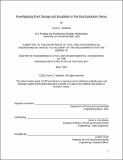Investigating Root Storage and Exudation in the Brachypodium Genus
Author(s)
Headrick, Kevin C.
DownloadThesis PDF (376.6Kb)
Advisor
Des Marais, David L.
Terms of use
Metadata
Show full item recordAbstract
In plants, sources are the tissues where a specific nutrient is absorbed or fixed into a plant, and sinks are the tissues in the plant where the nutrients are dispersed after they are absorbed or fixed. In the case of carbon, leaves tend to be the source, as most photosynthesis occurs in the leaves, and one of the sinks for carbon are root tissues. Because carbon-based compounds are the main source of cellular energy in plants, understanding the source-sink dynamics of carbon in plants gives us an insight into which functions or processes the plat is investing in. Specifically, the two aspects of source sink dynamics we investigate in this study are root exudation and root storage. We look at the difference of exudation between annual and perennial species and compare the levels of carbon storage in roots that arise from shoot apical meristems or from root apical meristems. These two functions occur in response to surplus carbon content in a plant, which we artificially prompted by withholding nitrogen from our plants. We use multiple species from the Brachypodium genus, an annual, B. distachyon, and a perennial, B. sylvaticum for this study. We chose this genus because it has evolved annuality and perenniality multiple times, and it is a good model for several economically valuable species. Most conclusively, we found that there is a significantly higher levels of carbon storage in shoot-borne roots compared to seminal root tissues.
Date issued
2022-05Department
Massachusetts Institute of Technology. Department of Civil and Environmental EngineeringPublisher
Massachusetts Institute of Technology